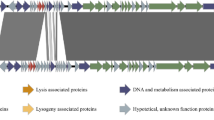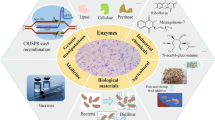Abstract
Phage endolysins have received increased attention in recent times as potential antibacterial agents and the biopreservatives in food production processes. Staphylococcus aureus is one of the most common pathogens in bacterial food poisoning outbreaks. In this study, the endolysin Lysdb, one of the two-component cell lysis cassette of Lactobacillus delbrueckii phage phiLdb, was shown to possess a muramidase domain and catalytic sites with homology to Chalaropsis-type lysozymes. Peptidoglycan hydrolytic bond specificity determination revealed that Lysdb was able to cleave the 6-O-acetylated peptidoglycans present in the cell walls of S. aureus. Turbidity reduction assays demonstrated that Lysdb could effectively lyse the S. aureus live cells under acidic and mesothermal conditions. To further evaluate the ability of Lysdb as a potential antibacterial agent against S. aureus in cheese manufacture, Lactobacillus casei BL23 was engineered to constitutively deliver active Lysdb to challenge S. aureus in lab-scale cheese making from raw milk. Compared with the raw milk, the viable counts of S. aureus were reduced by 105-fold in the cheese inoculated with the engineered L. casei strain during the fermentation process, and the pathogenic bacterial numbers remained at a low level (104 CFU/g) after 6 weeks of ripening at 10 °C. Taken together, all results indicated that the Lysdb has the function as an effective tool for combating S. aureus during cheese manufacture from raw milk.






Similar content being viewed by others
References
Atrih A, Bacher G, Allmaier G, Williamson MP, Foster SJ (1999) Analysis of peptidoglycan structure from vegetative cells of Bacillus subtilis 168 and role of PBP 5 in peptidoglycan maturation. J Bacteriol 181:3956–3966
Callewaert L, Walmagh M, Michiels CW, Lavigne R (2011) Food applications of bacterial cell wall hydrolases. Curr Opin Biotechnol 22:164–171
Castellano P, Aristoy MC, Sentandreu MA, Vignolo G, Toldrá F (2015) Lactobacillus sakei CRL1862 improves safety and protein hydrolysis in meat systems. J Appl Microbiol 113:1407–1416
Catalão MJ, Gil F, Moniz-Pereira J, São-José C, Pimentel M (2012) Diversity in bacterial lysis systems: bacteriophages show the way. FEMS Microbiol Rev 37:554–571
De Buyser ML, Dufour B, Maire M, Lafarge V (2001) Implication of milk and milk products in food-borne diseases in France and in different industrialised countries. Int J Food Microbiol 67:1–17
Delbes C, Alomar J, Chougui N, Martin JF, Montel MC (2006) Staphylococcus aureus growth and enterotoxin production during the manufacture of uncooked, semihard cheese from cows raw milk. J Food Prot 69:2161–2167
Endersen L, O’Mahony J, Hill C, Ross RP, McAuliffe O, Coffey A (2014) Phage therapy in the food industry. Annu Rev Food Sci T 5:327–349
Enouf V, Langella P, Commissaire J, Cohen J, Corthier G (2001) Bovine rotavirus nonstructural protein 4 produced by Lactococcus lactis is antigenic and immunogenic. Appl Environ Microbiol 67:1423–1428
Fischetti VA (2008) Bacteriophage lysins as effective antibacterials. Curr Opin Microbiol 11:393–400
Fischetti VA (2010) Bacteriophage endolysins: a novel anti-infective to control Gram-positive pathogens. Int J Med Microbiol 300:357–362
Fleurot I, Aigle M, Fleurot R, Darrigo C, Hennekinne JA, Gruss A, Borezée-Durant E, Delacroix-Buchet A (2014) Following pathogen development and gene expression in a food ecosystem: the case of a Staphylococcus aureus isolated in cheese. Appl Environ Microbiol 80:5106–5115
Gaeng S, Scherer S, Neve H, Loessner MJ (2000) Gene cloning and expression and secretion of Listeria monocytogens bacteriophage-lytic enzymes in Lactococcus lactis. Appl Environ Microbiol 66:2951–2958
Gervasi T, Horn N, Wegmann U, Dugo G, Narbad A, Mayer MJ (2014a) Expression and delivery of an endolysin to combat Clostridium perfringens. Appl Microbiol Biotechnol 98:2495–2505
Gervasi T, Lo Gurto R, Minniti E, Narbad A, Mayer MJ (2014b) Application of Lactobacillus johnsonii expressing phage endolysin for control of Clostridium perfringens. Lett Appl Microbiol 59:355–361
Gücükoğlu A, Kevenk O, Uyanik T, Cadirci Ő, Terzi G, Alisarli M (2012) Detection of enterotoxigenic Staphylococcus aureus in raw milk and dairy products by multiplex PCR. J Food Sci 77:620–623
Guo T, Kong J, Zhang L, Zhang C, Hu S (2012) Fine tuning of the lactate and diacetyl production through promoter engineering in Lactococcus lactis. PLoS One 7(4):e36296
Hazebrouck S, Pothelune L, Azevedo V, Corthier G, Wal JM, Langella P (2007) Efficient production and secretion of bovine beta-lactoglobulin by Lactobacillus casei. Microb Cell Factories 6:12
Hugenholtz J (2008) The lactic acid bacterium as a cell factory for food ingredient production. Int Dairy J 18:466–475
Jorgensen HJ, Mork T, Hogasen HR, Rovik LM (2005) Enterotoxigenic Staphylococcus aureus in bulk milk in Norway. J Appl Microbiol 99:158–167
Lebeer S, Vanderleyden J, De Keersmaecker SC (2008) Genes and molecules of lactobacilli supporting probiotic action. Microbiol Mol Biol Rev 72:728–764
Mayer MJ, Gasson MJ, Narbad A (2012) Genomic sequence of bacteriophage ATCC 8074-B1 and activity of its endolysin and engineered variants against Clostridium sporogenes. Appl Environ Microbiol 78:3685–3692
Morello E, Bermúdez-Humarán LG, Llull D, Solé V, Miraglio N, Langella P, Poquet I (2008) Lactococcus lactis, an efficient cell factory for recombinant protein production and secretion. J Mol Microbiol Biotechnol 14:48–58
Obeso JM, Martínez B, Rodríguez A, García P (2008) Lytic activity of the recombinant staphylococcal bacteriophage φH5 endolysin active against Staphylococcus aureus in milk. Int J Food Microbiol 128:212–218
O’Flaherty S, Coffey A, Meaney W, Fitzgerald GF, Ross RP (2005) The recombinant phage lysin LysK has a broad spectrum of lytic activity against clinically relevant staphylococci, including methicillin-resistant Staphylococcus aureus. J Bacteriol 187:7161–7164
Oliveira H, Melo LD, Santos SB, Nóbrega FL, Ferreira EC, Cerca N, Azeredo J, Kluskens LD (2013) Molecular aspects and comparative genomics of bacteriophage endolysins. J Virol 87:4558–4570
Park J, Yun J, Lim J-A, Kang D-H, Ryu S (2012) Characterization of an endolysin, LysBPS13, from a Bacillus cereus bacteriophage. FEMS Microbiol Lett 332:76–83
Pérez-Dorado I, Campillo NE, Monterroso B, Hesek D, Lee M, Páez JA, García JL, Mobashery S, Menéndez M, Hermoso JA (2007) Elucidation of the molecular recognition of bacteria cell wall by modular pneumococcal phage endolysin CPL-1. J Biol Chem 282:24990–24999
Rau A, Hogg T, Marquardt R, Hilgenfeld R (2000) A new lysozyme fold. Crystal structure of the muramidase from Streptomyces coelicolor at 1.65 Å resolution. J Biol Chem 276:31994–31999
Rochat T, Gratadoux JJ, Gruss A, Corthier G, Maguin E, Langella P, van de Guchte M (2006) Production of a heterologous nonheme catalase by Lactobacillus casei: an efficient tool for removal of H2O2 and protection of Lactobacillus bulgaricus from oxidative stress in milk. Appl Environ Microbiol 72:5143–5149
Rodríguez-Rubio L, Martínez B, Rodríguez A, Donovan DM, García P (2012) Enhanced staphylolytic activity of the staphlococcus aureus bacteriophage vB_SauS-phiIPLA88 HydH5 virion-associated peptidoglygan hydrolase: fusions, deletions, and synergy with LysH5. Appl Environ Microbiol 78:2241–2248
Rodríguez-Rubio L, Gutiérrez D, Donovan DM, Martínez B, Rodríguez A, García P (2015) Phage lytic proteins: biotechnological applications beyond clinical antimicrobials. Crit Rev Biotechnol 0:1–11
Sambrook J, Russell D (2001) Molecular cloning: a laboratory manual, vol 1–3. Cold Spring Harbor Laboratory Press, Cold Spring Harbor, New York
Settanni L, Moschetti G (2010) Non-starter lactic acid bacteria used to improve cheese quality and provide health benefits. Food Microbiol 27:691–697
Thompson K, Collins MA (1996) Improvement in electroporation efficiency for Lactobacillus plantarum by the inclusion of high concentrations of glycine in the growth medium. J Micro Methods 26:73–79
Tilkens B, King AM, Glass KA, Sinderlar JJ (2015) Validating the inhibition of Staphylococcus aureus in shelf-stable, ready-to-eat snack sausages with varying combinations of pH and water activity. J Food Prot 78:1215–1220
van de Guchte M, Penaud S, Grimaldi C, Barbe V, Bryson K, Nicolas P, Robert C, Oztas S, Mangenot S, Couloux A, Loux V, Dervyn R, Bossy R, Bolotin A, Batto J-M, Walunas T, Gibrat J-F, Bessières P, Weissenbach J, Ehrlich SD, Maguin E (2006) The complete genome sequence of Lactobacillus bulgaricus reveals extensive and ongoing reductive evolution. Proc Natl Acad Sci U S A 103:9274–9279
Walcher G, Gonano M, Kümmel J, Barker GC, Lebl K, Bereuter O, Ehling-Schulz M, Wagner M, Stessl B (2014) Staphylocuccus aureus reservoirs during traditional Austrian raw milk cheese production. J Dairy Res 81:462–470
Wang S, Kong J, Zhang X (2008) Identification and characterization of the two-component cell lysis cassette encoded by temperate bacteriophage φPYB5 of Lactobacillus fermentum. J Appl Microbiol 105:1939–1944
Wang S, Kong J, Gao C, Guo T, Liu X (2010) Isolation and characterization of a novel virulent phage (phiLdb) of Lactobacillus delbrueckii. Int J Food Microbiol 137:22–27
White R, Chiba S, Pang T, Dewey JS, Savva CG, Holzenburg A, Pogliano K, Young R (2011) Holin triggering in real time. Proc Natl Acad Sci U S A 108:798–803
Xu Y, Kong J (2013) Construction and potential application of controlled autolytic systems for Lactobacillus casei in cheese manufacture. J Food Prot 76:1187–1193
Yoong P, Schuch R, Nelson D, Fischetti VA (2004) Identification of a broadly active phage lytic enzyme with lethal activity against antibiotic-resistant Enterococcus faecalis and Enterococcus faecium. J Bacteriol 186:4808–4812
Young R (2013) Phage lysis: do we have the hole story yet? Curr Opin Microbiol 16:790–797
Zhang H, Bao H, Billington C, Hudson JA, Wang R (2012) Isolation and lytic activity of the Listeria bacteriophage endolysin LysZ5 against Listeria monocytogenes in soya milk. Food Microbiol 31:133–136
Acknowledgments
We would like to thank M. van de Guchte, S. Hazebrouck, and N. Galleron for the kindness of providing L. delbrueckii subsp. bulgaricus ATCC11842, L. casei BL23, and pSec:Nuc vector, respectively. This work was supported by grants from the National Natural Science Foundation of China (grant no. 31271905), Hi-tech Research and Development Program of China (no. 2011AA100902), and the Fundamental Research Funds of Shandong University (no. 2014GN024).
Author information
Authors and Affiliations
Corresponding author
Ethics declarations
Conflict of interest
The authors declare that they have no conflict of interest.
Human and animal rights and informed consent
This article does not contain any studies with human participants or animals performed by any of the authors.
Rights and permissions
About this article
Cite this article
Guo, T., Xin, Y., Zhang, C. et al. The potential of the endolysin Lysdb from Lactobacillus delbrueckii phage for combating Staphylococcus aureus during cheese manufacture from raw milk. Appl Microbiol Biotechnol 100, 3545–3554 (2016). https://doi.org/10.1007/s00253-015-7185-x
Received:
Revised:
Accepted:
Published:
Issue Date:
DOI: https://doi.org/10.1007/s00253-015-7185-x




